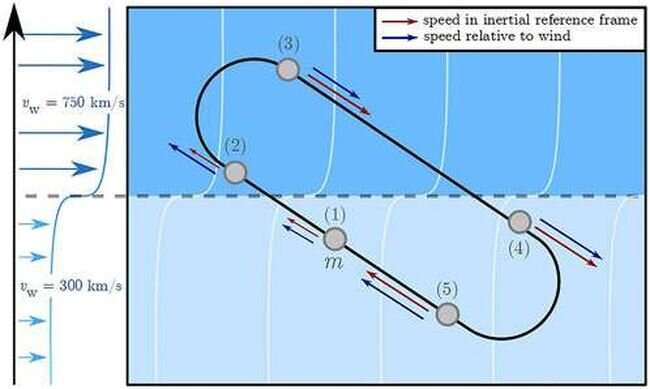
Copernical Team
Mars megatsunami may have been caused by Chicxulub-like asteroid impact
 A Martian megatsunami may have been caused by an asteroid collision similar to the Chicxulub impact - which contributed to the mass extinction of all non-avian dinosaurs on Earth 66 million years ago - in a shallow ocean region, according to a study published in Scientific Reports.
Previous research has proposed that an asteroid or comet impact within an ocean in the Martian northern lowla
A Martian megatsunami may have been caused by an asteroid collision similar to the Chicxulub impact - which contributed to the mass extinction of all non-avian dinosaurs on Earth 66 million years ago - in a shallow ocean region, according to a study published in Scientific Reports.
Previous research has proposed that an asteroid or comet impact within an ocean in the Martian northern lowla Chinese scientists complete rice, Arabidopsis life-cycle experiments in space
 Chinese scientists have completed the life-cycle growth experiments of rice and Arabidopsis in the Chinese space station and successfully obtained their seeds, said the Chinese Academy of Sciences (CAS) on Monday.
With the safe landing of the Shenzhou-14 spaceship's return capsule at the Dongfeng landing site Sunday night, the seeds of rice and Arabidopsis, which have undergone a 120-day l
Chinese scientists have completed the life-cycle growth experiments of rice and Arabidopsis in the Chinese space station and successfully obtained their seeds, said the Chinese Academy of Sciences (CAS) on Monday.
With the safe landing of the Shenzhou-14 spaceship's return capsule at the Dongfeng landing site Sunday night, the seeds of rice and Arabidopsis, which have undergone a 120-day l Elon Musk's SpaceX unveils Starshield satellite services for U.S. military
 SpaceX is rolling out a new business called Starshield to support U.S. military applications, building upon the company's existing satellite system.
The latest Elon Musk endeavor expands on Starlink Internet satellite technology for national security uses, to include secure communications and space surveillance payloads, for its largest customer, the Pentagon.
"While Starlink is
SpaceX is rolling out a new business called Starshield to support U.S. military applications, building upon the company's existing satellite system.
The latest Elon Musk endeavor expands on Starlink Internet satellite technology for national security uses, to include secure communications and space surveillance payloads, for its largest customer, the Pentagon.
"While Starlink is Rocket Lab introduces dedicated national security subsidiary
 Rocket Lab USA, Inc. (Nasdaq: RKLB) has created a U.S.-based wholly owned subsidiary to serve the defense and intelligence community. Rocket Lab National Security LLC (RLNS) will deliver reliable launch services and space systems capabilities to the U.S. government and its allies.
Since the Company's first launch of the Electron rocket in 2017, Rocket Lab has conducted multiple successful
Rocket Lab USA, Inc. (Nasdaq: RKLB) has created a U.S.-based wholly owned subsidiary to serve the defense and intelligence community. Rocket Lab National Security LLC (RLNS) will deliver reliable launch services and space systems capabilities to the U.S. government and its allies.
Since the Company's first launch of the Electron rocket in 2017, Rocket Lab has conducted multiple successful Momentus to Fly JINJUSat-1 for CONTEC
 Momentus Inc. (NASDAQ: MNTS) has signed a contract with CONTEC Co. of the Republic of Korea to provide space transportation services for the JINJUSat-1 CubeSat.
JINJUSat-1 is spearheaded by three entities: Jinju City, Korea Testing Laboratory, and Gyeongsang National University. The satellite is targeted to launch aboard the SpaceX Transporter-9 mission no earlier than October 2023. Once i
Momentus Inc. (NASDAQ: MNTS) has signed a contract with CONTEC Co. of the Republic of Korea to provide space transportation services for the JINJUSat-1 CubeSat.
JINJUSat-1 is spearheaded by three entities: Jinju City, Korea Testing Laboratory, and Gyeongsang National University. The satellite is targeted to launch aboard the SpaceX Transporter-9 mission no earlier than October 2023. Once i Britain set to launch its first space mission
 A tentative date has been set for Britain's first space launch.
A launch window for Virgin Orbit's LauncherOne is scheduled to open Dec. 14, NASA's spaceflight editor Chris Bergin tweeted Tuesday.
Virgin Orbit's LauncherOne system has been used on five prior occasions but those missions departed from the Mojave Air and Space Port in California.
The upcoming LauncherOne mis
A tentative date has been set for Britain's first space launch.
A launch window for Virgin Orbit's LauncherOne is scheduled to open Dec. 14, NASA's spaceflight editor Chris Bergin tweeted Tuesday.
Virgin Orbit's LauncherOne system has been used on five prior occasions but those missions departed from the Mojave Air and Space Port in California.
The upcoming LauncherOne mis Maybe we don't see aliens because they're waiting to hear a signal from us first

We've had a long-running series here at UT on potential solutions Fermi paradox—why aren't we able to detect any alien life out there in the Universe? But more possible solutions are being developed all the time. Now, another paper adds some additional theory to one of the more popular solutions—that aliens are just too busy to care about us.
The paper, released on arXiv, was written by Amri Wandel of the Racah Institute of Physics at the Hebrew University of Jerusalem. It makes two basic assumptions. First, aliens don't really care about planets with life on them. Second, they would care if they could detect intelligent life on one.
For the first assumption to be valid, it would help if the occurrence of "biotic" (i.e., having biology) planets is widespread. In that case, even advanced civilizations might not have enough resources to devote to fully exploring those planets, especially in the form of an actual probe.
Proposing a new idea for spacecraft propulsion that involves dynamic soaring

A team of researchers from McGill University and the Tau Zero Foundation is proposing a new idea for faster spacecraft propulsion that involves dynamic soaring. In their paper published in the journal Frontiers in Space Technology, the group outlines the idea of dynamic soaring as it applies to a speedy way to move through space and other possible uses for it.
Over the past several decades, as human-built space vehicles have made their way to many of the planets and moons in our solar system, it has become clear that a means is required for creating spacecraft that can get to distant destinations in space much faster.
Coming soon: MTG The Next Generation
 Video:
00:00:48
Video:
00:00:48
One week today, the first of a new generation of weather satellites will take to the skies. The Meteosat Third Generation system is the most complex and innovative meteorological satellite system ever built. It will bring new capabilities to monitor weather, climate and the environment from space like never before – promising to further bolster Europe’s leadership in weather forecasting.
Join us for the live launch coverage of the Metetosat Third Generation Imager on 13 December on ESA Web TV.
China's Shenzhou-14 astronauts return safely, accomplishing many "firsts"
 Three Chinese astronauts on board the Shenzhou-14 manned spaceship returned to Earth safely on Sunday, after accomplishing many "firsts" during their six-month space station mission.
Shenzhou-14's return capsule, carrying astronauts Chen Dong, Liu Yang and Cai Xuzhe, touched down at the Dongfeng landing site in north China's Inner Mongolia Autonomous Region at 8:09 p.m. Beijing Time, accor
Three Chinese astronauts on board the Shenzhou-14 manned spaceship returned to Earth safely on Sunday, after accomplishing many "firsts" during their six-month space station mission.
Shenzhou-14's return capsule, carrying astronauts Chen Dong, Liu Yang and Cai Xuzhe, touched down at the Dongfeng landing site in north China's Inner Mongolia Autonomous Region at 8:09 p.m. Beijing Time, accor 
